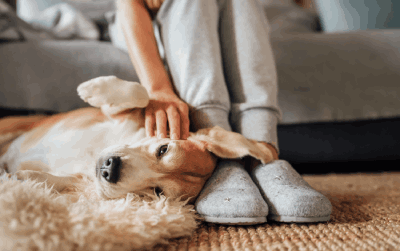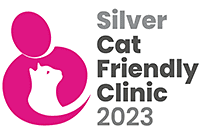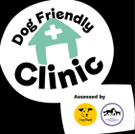Dog friendly pre visit guidance
In preparation of taking your dog to the vet we have pulled together some pre visit guidance.
Get your dog used to being touched at home
Start at home by touching them on a part of their body you know they’re comfortable with. This is often the chest or behind the ears. Leave your hand there for no more than three seconds, then give them a treat and let them relax.
Touching a new area
Gradually move your hand to a new area, perhaps the front leg, for a maximum of three seconds, and give a treat each time. If your dog looks uncomfortable, stop what you are doing.
Remember to take this ‘touch and treat’ approach slowly. You’re aiming to be able to eventually touch your dog on their paws, lift their tail, check their ears and look in their mouth – all of the things a vet may need to do during an examination. Increase the time very slowly; you can lengthen the time you leave your hand on them, building up from three to 10 seconds.
Please click on the link to learn training tips to help your animal with vet visits Taking Your Dog To The Vet | Visiting the Vet | Dogs Trust
Tips for the pre-traveling and during travel
Please click on the link to learn how to make public travel more dog-friendly Using Public Transport With Your Dog | Dog Advice | Dogs Trust
Please click on the link to learn how to make car journeys more dog-friendly Train Your Dog To Travel In The Car | Training | Dogs Trust
Pheromones can be used to help with travel stress. ADAPTIL transport has been clinically proven to reduce panting, agitation, and restlessness during travel. Please find more information on Help your dog feeling comfortable when travelling (adaptil.com)
Tips when you arrive in the practice
Please let us know if your dog is anxious about visiting the vet so we can help you prepare for the visit.
- When you visit the vet with your dog, try bringing their favourite toy, blanket, or both. This should help them feel more relaxed and secure.
- Avoid sitting next to doorways. Dogs can find it difficult to relax near busy areas, so the further away you can be, the better.
- It can also be helpful to make sure your dog is facing away and spaced out from other dogs. That’ll be easier if you make an appointment for a quieter time at the vet practice.
- Gently encourage your dog to focus on you. This will help them avoid eye contact with other dogs, which is often a cause of tension or frustration within the confined space of a waiting room.
- Please follow dog-friendly guidance in our reception area to help your dog settle and take advantage of Nurse lead socialisation clinics to help make your dogs visit fun and more enjoyable.
To learn more about your dog’s body language, please visit How to Understand Your Dog’s Body Language | Dogs Trust and Signs of Stress In Dogs | Anxious Dogs | Dogs Trust.







